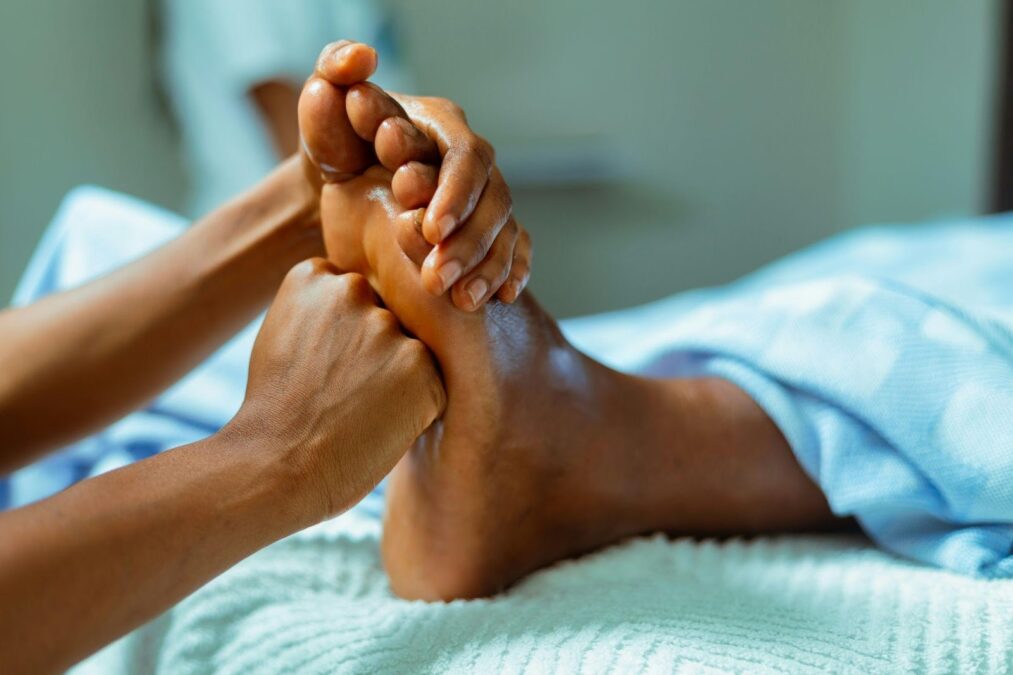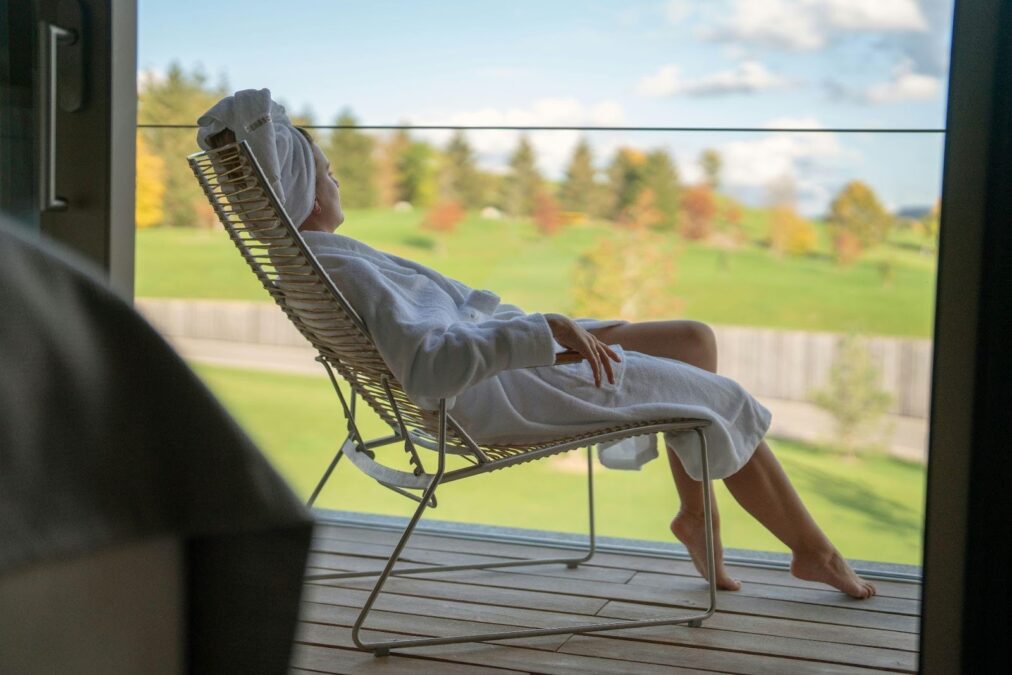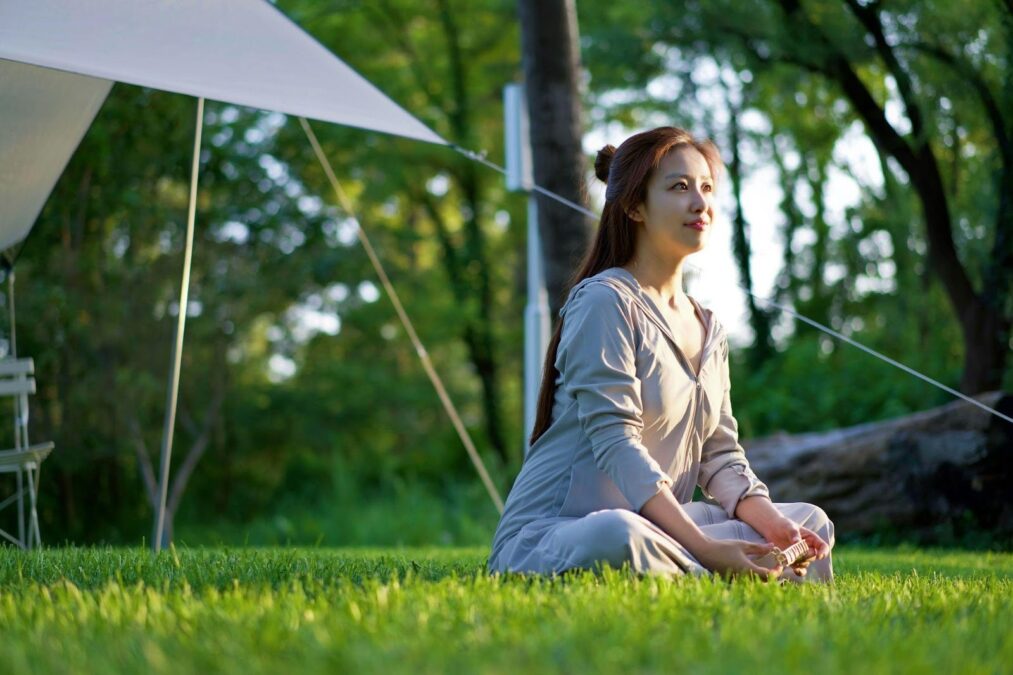Step into a modern wellness center and you’ll encounter technologies that seem almost alien in their sophistication. Chairs that contour to your body with uncanny precision, their mechanical hands kneading muscles with rhythms mimicking expert human touch. Biometric sensors reading your stress levels through subtle physiological signals. Meditation apps using algorithms to personalize calming soundscapes based on your breathing patterns, there’s something decidedly futuristic about these relaxation technologies.
Combining relaxation techniques with preventive healthcare represents a shift from viewing these as separate domains to recognizing their fundamental interconnection. Relaxation isn’t what you do after healthcare, it’s an integral component of maintaining health proactively.
The Importance of Relaxation for Preventive Health
Physiological Benefits
Relaxation delivers measurable, clinically significant improvements in physical health markers that directly reduce disease risk.
Blood pressure and heart rate decrease during relaxation, providing cardiovascular relief. Chronic hypertension damages blood vessels and strains the heart, increasing stroke and heart attack risk substantially. Regular relaxation practice can lower blood pressure as effectively as some medications for people with mild hypertension, while also benefiting those with normal blood pressure by preventing future elevation.
Cortisol reduction might be relaxation’s most impactful benefit. Cortisol—the primary stress hormone serves important functions in short bursts but becomes destructive when chronically elevated. High cortisol promotes abdominal fat accumulation, impairs immune function, disrupts sleep, accelerates cognitive decline, and contributes to depression and anxiety. Relaxation techniques directly counter this by activating the parasympathetic nervous system, which reduces cortisol production while promoting repair and restoration processes.
Immune function improves with regular relaxation. Chronic stress suppresses immune response, making you more susceptible to infections and potentially affecting cancer surveillance. Conversely, relaxation practices enhance immune cell activity and improve vaccination response.
Mental and Emotional Benefits
The psychological benefits of relaxation extend beyond simply feeling less stressed in the moment—they create lasting improvements in mental health and cognitive function.
Mood improvements occur through multiple mechanisms. Relaxation increases production of neurotransmitters like serotonin and GABA that promote calmness and well-being. It reduces rumination, the repetitive negative thinking that fuels depression and anxiety. Regular relaxation practice can reduce depression and anxiety symptoms as effectively as some therapeutic interventions.
Focus and cognitive function enhance through relaxation. Chronic stress impairs attention, working memory, and executive function—the mental processes managing complex tasks.
Emotional resilience—the capacity to handle challenges without becoming overwhelmed, develops through consistent relaxation practice. You still encounter stressors, but your response becomes more measured and less physiologically damaging.
Understanding Preventive Healthcare
Core Components of Preventive Care
Preventive healthcare encompasses all strategies designed to prevent disease or detect problems early when they’re most treatable.
Routine check-ups establish health baselines and track changes over time. Annual physical exams assess vital signs, review symptoms, and provide opportunities to discuss health concerns.
Screenings detect problems before symptoms appear—blood pressure checks, cholesterol panels, glucose tests, cancer screenings appropriate for age and risk factors, vision and hearing exams. Early detection dramatically improves outcomes for most conditions.
Vaccinations prevent infectious diseases, protecting both individual health and community immunity.
Linking Relaxation to Prevention
Stress management through relaxation isn’t separate from preventive care—it’s a core component deserving equal emphasis alongside diet, exercise, and sleep.
Cardiovascular protection from stress reduction rivals benefits of many medications. Chronic stress promotes atherosclerosis (arterial plaque), increases blood clotting risk, and triggers irregular heart rhythms. Relaxation counters all these mechanisms.
Metabolic health improves with stress management. Cortisol promotes insulin resistance and fat accumulation, particularly dangerous visceral fat surrounding organs. Reducing stress through relaxation improves insulin sensitivity and supports healthy metabolism.
Adherence to health routines improves when relaxation reduces overall stress burden. People managing stress effectively find it easier to maintain exercise routines, make healthy food choices, and keep medical appointments—stress often derails these intentions.
Effective Relaxation Techniques
Mind-Body Practices
Practices explicitly connecting mental focus with physical relaxation deliver particularly comprehensive benefits.
Yoga combines physical postures, breathing control, and meditation, delivering flexibility, strength, relaxation, and mental calm simultaneously. Even gentle yoga styles provide substantial benefits. Regular practice reduces anxiety and depression while improving physical function.
Meditation trains attention and awareness, reducing rumination and reactivity to stressors. Contrary to popular belief, meditation doesn’t require clearing your mind completely—it’s about noticing thoughts without getting caught in them. Even brief daily practice (5-10 minutes) provides measurable benefits, with effects increasing with consistency.
Deep breathing exercises activate the parasympathetic nervous system almost immediately. Simple techniques like box breathing (inhale 4 counts, hold 4, exhale 4, hold 4, repeat) or diaphragmatic breathing can reduce acute stress within minutes. These techniques work anywhere, anytime, requiring no equipment or special setting.
Benefits accumulate across all these practices: improved flexibility and body awareness, reduced anxiety and depression, better sleep quality, enhanced emotional regulation, and increased stress resilience.
Physical Relaxation Tools
Technology offers increasingly sophisticated tools for physical relaxation that complement mind-body practices.
Massage chairs have evolved from simple vibrating seats to sophisticated devices delivering targeted muscle work rivaling professional massage. Quality massage chairs provide multiple benefits:
- Muscle tension relief through kneading, rolling, and percussion techniques addressing common problem areas like neck, shoulders, and lower back
- Improved circulation as massage promotes blood flow, delivering oxygen and nutrients while removing metabolic waste
- Pain management for chronic conditions like back pain, helping many people reduce medication dependence
- Posture improvement as regular use helps relax chronically tight muscles that pull bodies into poor alignment
- Convenient home access to massage therapy without scheduling appointments or travel
Modern massage chairs offer customizable programs, heat therapy, zero-gravity positioning, and body scanning that tailors massage to your specific anatomy. While quality chairs represent significant investment, the cost per use over years often proves more economical than regular professional massage while providing immediate access whenever needed.
Other physical relaxation tools include foam rollers for self-myofascial release, percussion massage devices targeting specific areas, heating pads or warm baths for muscle relaxation, and weighted blankets providing calming pressure.
Scheduling Relaxation in a Busy Life

Time Management Strategies
The primary barrier to relaxation isn’t lack of knowledge but perceived lack of time. Strategic scheduling makes relaxation sustainable.
Short daily sessions work better than occasional long sessions. Ten minutes of meditation daily provides more cumulative benefit than an hour-long session once weekly. Brief practices integrate more easily into packed schedules while building habits through frequent repetition.
Mini-relaxation breaks throughout workdays prevent stress accumulation. Simple practices taking just minutes provide significant relief:
- Two-minute breathing exercises between meetings
- Brief stretching after prolonged sitting
- Five-minute walking breaks outdoors
- Progressive muscle relaxation at your desk
Transition rituals between work and home life create mental separation. A brief meditation, short walk, or relaxation session in your car before entering home helps you disengage from work stress rather than carrying it into personal time.
Combining Relaxation With Physical Activity
Physical activity and relaxation aren’t separate—they can be integrated synergistically.
Cool-down stretches after exercise provide both physical and mental relaxation. Spending 5-10 minutes stretching major muscle groups prevents next-day soreness while transitioning from exercise intensity to relaxation.
Walking meditation or mindful walking combines gentle cardiovascular activity with meditative awareness. Rather than vigorous exercise, you walk at comfortable pace while focusing attention on movement sensations, breathing, or surroundings.
Restorative yoga bridges exercise and relaxation—gentle enough to calm the nervous system while still providing movement benefits. This works particularly well for active rest days between more intense workouts.
Preventive Healthcare Practices Enhanced by Relaxation

Routine Health Monitoring
Regular health monitoring forms the foundation of preventive care, and relaxation supports this by reducing one of the major threats to health.
Tracking trends matters more than individual measurements. Single elevated readings might reflect temporary stress or measurement error, but patterns over time reveal true health status and whether interventions are working.
Professional Guidance
Healthcare professionals provide personalized preventive strategies accounting for your unique health history, risk factors, and circumstances.
Consulting specialists like Dr Gan Eng Cern and similar healthcare providers in your area offers expert guidance on preventive care appropriate for your specific situation. These professionals can identify risk factors you might overlook, recommend screening timing based on personal and family history, and provide medical interventions when lifestyle modifications alone prove insufficient.
Integrating medical advice with lifestyle and relaxation routines creates comprehensive prevention. Your doctor might recommend specific stress-reduction techniques relevant to your health concerns—perhaps meditation for hypertension, yoga for chronic pain, or structured relaxation for anxiety disorders. This integration ensures relaxation practices complement rather than substitute for necessary medical care.
Creating a Relaxing Home Environment
Space and Ambiance
Your physical environment significantly influences your capacity to relax. Creating spaces conducive to relaxation doesn’t require extensive renovation—thoughtful modifications often suffice.
Quiet, clutter-free areas promote relaxation far better than chaotic spaces. Designate even a small corner as your relaxation zone—somewhere you can sit comfortably without visual chaos or noise disruption. This might be a bedroom corner, a spot in your living room, or even a comfortable chair on a balcony.
Lighting profoundly affects mood and relaxation capacity. Harsh overhead lighting activates stress responses while warm, dim lighting promotes calm. Consider adjustable lighting, lamps rather than overhead fixtures, or candles for relaxation periods.
Sound or its absence shapes relaxation. Some people need silence while others find soft music, nature sounds, or white noise more relaxing. Noise-canceling headphones help create quiet in chaotic environments.
Integrating Tools and Technology
Modern technology offers tools supporting both relaxation and health monitoring.
Massage chairs and similar relaxation devices become increasingly valuable with regular use. If budget permits, quality massage chairs provide daily stress relief without scheduling or travel. Position them in comfortable, private spaces where you’ll actually use them regularly rather than treating them as furniture.
Wearables like fitness trackers or smartwatches now include stress monitoring features, sleep tracking, and breathing exercise prompts. These tools help you recognize stress patterns you might not consciously notice and track whether relaxation practices are improving physiological
Lifestyle Choices That Complement Relaxation
Nutrition and Hydration
Dietary choices influence both stress levels and relaxation capacity.
Anti-inflammatory foods support stress resilience. Diets emphasizing vegetables, fruits, whole grains, fatty fish, nuts, and olive oil reduce systemic inflammation that chronic stress promotes. Conversely, processed foods, excess sugar, and trans fats increase inflammation.
Mental clarity improves with stable blood sugar. Balanced meals with protein, complex carbohydrates, and healthy fats prevent the energy crashes and mood swings from blood sugar spikes and drops. These crashes increase stress reactivity and undermine relaxation efforts.
Hydration affects everything from cognitive function to physical comfort. Even mild dehydration impairs mood, concentration, and stress tolerance. Adequate water intake throughout the day supports both optimal function and relaxation capacity.
Sleep and Recovery
Sleep might be relaxation’s most important component, yet it’s often sacrificed when life gets busy.
Consistent sleep schedules synchronize with your natural circadian rhythm, improving both sleep quality and daytime function. Try maintaining similar sleep and wake times even on weekends.
Sleep hygiene practices create conditions supporting quality rest:
- Cool, dark, quiet bedroom
- Avoiding screens 30-60 minutes before bed
- Limiting caffeine after early afternoon
- Avoiding large meals or alcohol close to bedtime
- Using bed only for sleep and intimacy (not work or TV)
Relaxation techniques specifically improving sleep include progressive muscle relaxation, body scan meditation, or breathing exercises performed in bed. These redirect attention from racing thoughts while activating physiological relaxation.
Long-Term Benefits of Combining Relaxation and Preventive Care

Physical Health
Consistent integration of relaxation with preventive care delivers compounding benefits over time.
Chronic disease risk decreases substantially. Regular relaxation practice combined with other preventive measures reduces risk for cardiovascular disease, type 2 diabetes, certain cancers, and neurodegenerative conditions. The combination proves more protective than any single intervention alone.
Mobility, posture, and energy improve through the combination of stress reduction and physical self-care. Chronic muscle tension from stress impairs posture and movement quality. Regular relaxation releases this tension while practices like yoga and stretching maintain flexibility and strength.
Mental and Emotional Wellbeing
The psychological benefits of consistent relaxation practice extend far beyond stress reduction.
Stress resilience develops—you still encounter challenges, but your response becomes less reactive and damaging. This resilience protects mental health while making you more effective at handling life’s inevitable difficulties.
Focus and productivity improve paradoxically through regular relaxation. Counter to “hustle culture” suggesting constant work produces best results, regular breaks and relaxation actually enhance performance by preventing burnout and maintaining cognitive function.
Life satisfaction increases when you feel capable of managing stress, maintain physical health, and create regular opportunities for peace and restoration. This satisfaction feeds back into motivation for maintaining healthy practices.
Conclusion
Integrating relaxation practices with preventive healthcare represents one of the most impactful investments you can make in long-term health, vitality, and quality of life. The evidence is clear, chronic stress damages health across multiple systems, while regular relaxation provides measurable protective benefits rivaling many medical interventions.
The practical strategies explored here, from accessible tools like massage chairs providing convenient daily stress relief to professional guidance from healthcare providers offering personalized preventive strategies, make this integration achievable despite busy modern schedules. The key is recognizing that relaxation isn’t optional self-care but essential preventive medicine deserving the same priority as exercise, nutrition, and medical screenings.
